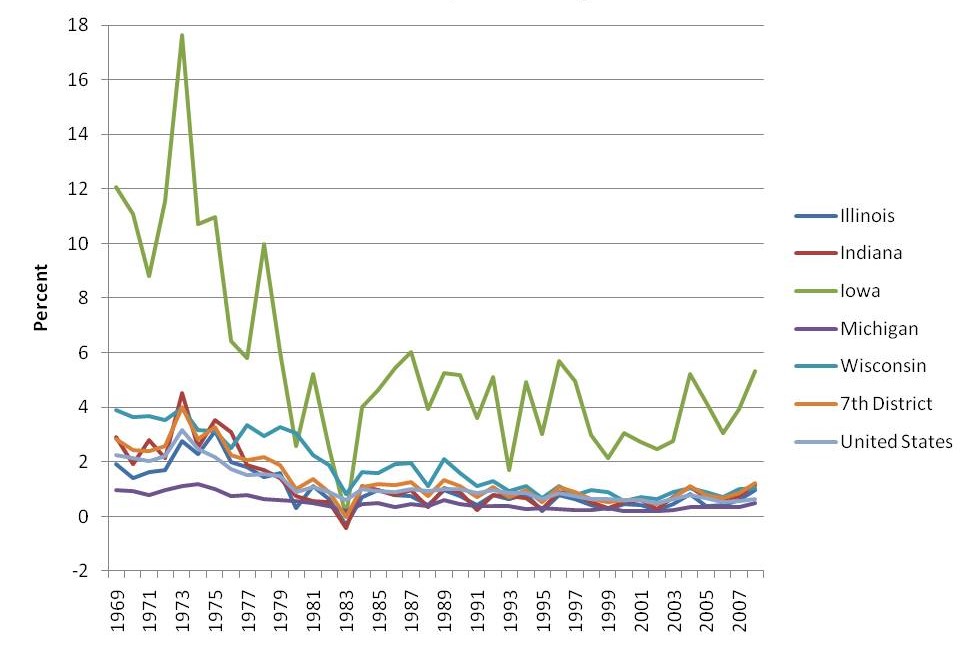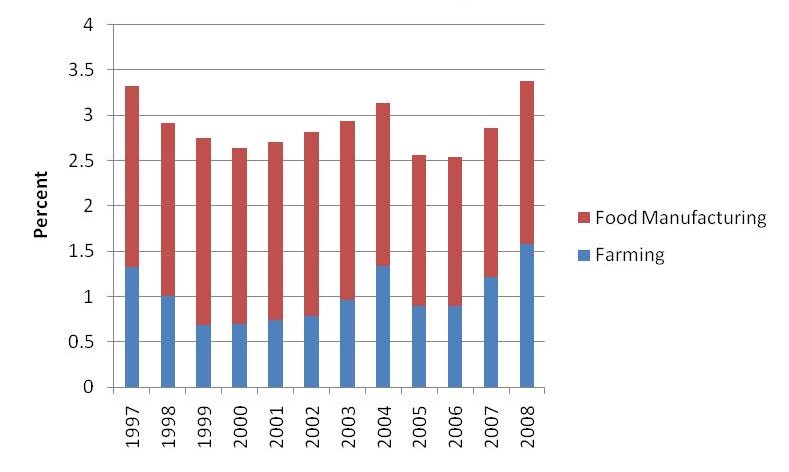Today’s Nexus Farming and Rural Development
David Oppedahl is the Federal Reserve Bank of Chicago’s business economist who researches agriculture and rural economies. This past fall, he held a conference that explored the changing nexus between farming and rural growth and development in the Midwest.
Farming activity itself directly generates a declining share of income in the Midwest, as it does in most other parts of the U.S. This may seem illogical because farm yields and production continue to soar in response to strong demand for grains and livestock—both from here and abroad. But in terms of income generated directly through farming, farm operations suffer from much the same phenomenon as many manufacturing industries—i.e., rising output volumes have not been sufficient to offset falling (real) prices. Falling prices have come about as productivity gains have lifted production yields while lowering the costs of production per unit1. In addition, productivity gains have been accomplished with greater use of labor-saving machinery and other technologically-advanced inputs such as seed and pesticides. The chart below documents the smaller share of personal income from farming in the states of the Seventh Federal Reserve District.
1. Total farm income as a percent of personal income

While income generated from farming activity itself may be decreasing in importance to rural economies, income generated from activities related to farming is countering this trend. These activities include the processing of agricultural products (such as grain milling and oilseed processing); food preparation and packaging; and livestock slaughter and processing. Such activities usually take place nearby farms in order to save costs on transportation. To see the importance of such activities, see Oppedahl’s chart, which adds “food manufacturing” income to direct farming income. It is seen here that food processing alone doubles the income share contributed by agriculture to the Seventh District’s economy.
Farm products are also increasingly used as feedstocks for nonfood processing—the most prominent being biofuel processing. Although the manufacturing of biofuels has boosted the economies of many rural communities in the Midwest, the use of foodstuffs to meet energy needs is not without controversy on ethical, environmental, and cost-effectiveness grounds.
2. Seventh District output shares from farming and food manufacturing

Perhaps less controversial, greater local food sourcing was the focus of some discussions at Oppedahl’s recent conference. Farmers and other rural entrepreneurs are increasingly reshaping their products and distribution channels to meet changing demands for food. Local foods are being sourced and modified to meet or serve a growing segment of consumers who are more health- and eco-conscious. While local foods operations tend to be run at a smaller scale, employment and income may grow at them because some consumers see more value in their products (e.g., relative freshness)—and are willing to pay premium prices for them. In some instances, high-quality and special-feature farm products are being featured at local restaurants and accommodations, generating new food-oriented travel destinations. Aesthetically pleasing small-scale farms themselves may become vacation spots as a result of the explosion in popularity of locally and organically grown food products.
If you want to know more about how these trends are playing out in the Seventh District, check out the conference presentations from David Oppedahl’s conference, which are summarized in this month’s Chicago Fed Letter.
Footntoes
1 These price trends refer to the past several decades. Many farm commodity prices have risen over the past year.








